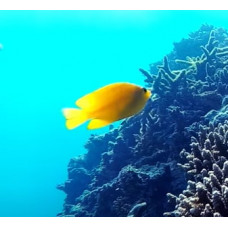Latin name
Pomacentrus moluccensis
Other name
Pomacentrus moluccensis
Identification
A fish with a deep body, compressed at the sides. The head is slightly longer than it is high, with large eyes and a slanting mouth. The teeth are in two rows with rounded tips.
Features of fish fins
The coloration of this fish is uniformly yellow with a small orange spot at the base of the pectoral fin (except in the Philippines).
Fish colouring
The dorsal fin has 13 spines and 13 to 14 soft rays. The anal fin has 2 spines and 14 soft rays; the first anal ray is half the size of the second. The first ray of the pelvic fins is strongly elongated and longer than the dorsal fin. The pectoral fins are slightly shorter, and the caudal fin is shallowly forked with rounded lobes.
Distribution
Widespread in the tropical western Pacific. Its range extends from about 32° north latitude to 32° south latitude and from 92° east longitude to 173° west longitude.
Habitat
A tropical marine species. Occurs at depths of about 14 m (46 ft) in lagoons with clear water and on reefs with branching corals that provide shelter.
Size
Reach a length of 9 centimeters (4 inches).
Behavior
Occurs on and around coral reefs in small groups. A diurnal species. Does not migrate.
Food and feeding habits
The diet consists mainly of algae, but planktonic invertebrates are also eaten.
Reproduction
This fish forms pairs during the breeding season. They lay eggs and mate during breeding. The eggs are on the bottom and adhere to the substrate. The males guard and aerate the eggs.
Fishing
This species is commercially important in fisheries.
Relationship with a person
If there are many fish in the tank, this species will chase the more peaceful inhabitants. If Pomacentrus moluccensis encounters a more aggressive fish and is the only species in the tank, it will usually turn around and swim away immediately.
| Classification | |
| Phylum | Chordata |
| Class | Actinopterygii |
| Family | Pomacentridae |
| Genus | Pomacentrus |
| Species | P. moluccensis |
| Features | |
| Conservation status | Least Concern |
| Habitat | Pelagic |
| Life span, years | No information |
| Maximum body weight, kg | No information |
| Maximum length, cm | 9 |
| Sailing speed, m/s | No information |
| Threat to people | Not edible |
| Way of eating | Planktonophage |
Lemon damselfish
Tags: lemon damselfish



